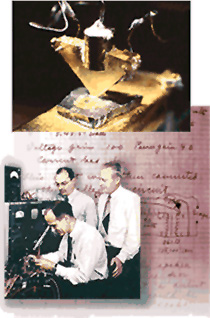November 17 - December 23, 1947: Invention of the First Transistor
|
Image from AT&T |
The story of the first transistor begins well before Bell Labs scientists first started working on developing such a device in the 1930s. It was scientists in the 1800s - including Maxwell, Hertz, and Faraday- who made the dramatic scientific discoveries that made it possible to harness electricity for human uses, while inventors applied this knowledge in the development of useful electrical devices like radio.
Wireless communication was born in 1895, when Marconi successfully sent a radio signal over a distance of more than a mile. But before the technology could be fully practical, better detectors needed to be developed to detect the radio signal carrying the information. Rectifying crystal detectors were eventually incorporated into radio receivers, which were able to separate the carrier wave from the part of the signal carrying the information.
However, crystal sets only worked with strong radio waves, which tend to weaken over distance and terrestrial obstructions. Amplification was needed. English physicist John Ambrose Fleming provided the first step towards a solution with his invention of the rectifying vacuum tube: a lightbulb outfitted with two electrodes attached to radio receiving systems. The American inventor Lee DeForest added a further innovation: a third electrode, called a grid, consisting of a network of small wires surrounding the cathode, with a negative potential that controlled the flow of electrons from the cathode to the anode, producing an amplifying current.
The amplifying vacuum tube was not only an essential component in the development of radio, but also in early telephone equipment, television sets, and computers. But the technology was less than perfect. Vacuum tubes consumed too much power, gave off too much heat, took up too much space, cost too much to produce, and eventually burned out and needed to be replaced. (The University of Pennsylvania's ENIAC computer, which incorporated thousands of vacuum tubes, filled several large rooms and consumed enough power to light ten homes.) These shortcomings prompted one Bell Labs engineer, J.R. Pierce, to proclaim, "Nature abhors the vacuum tube."
In the 1930s, Bell Labs scientists were trying to use ultrahigh frequency waves for telephone communications, and needed a more reliable detection method than the vacuum tube, which proved incapable of picking up rapid vibrations. They reverted to a crystal-based detector, which worked effectively and set them on the path of exploring the particular properties of the most reliable semiconductor material: silicon. In the process, they discovered that silicon was comprised of two distinct regions, one favoring positive current flow ("P") and one favoring negative current flow ("N"). The discovery of this "P-N junction", and the ability to control its properties, laid the foundation for the transistor.
John Bardeen, Walter Brattain and William Shockley spearheaded the Bell Labs effort to develop a new means of amplification, speculating that by adding a third electrode to the semiconductor detector, they would be able to control the amount of current flowing through the silicon. The resulting device would, theoretically, amplify as well as the vacuum tube with much less power consumption and in a fraction of the space.
The research efforts peaked during the so-called "Miracle Month:" November 17 to December 23, 1947. Brattain had built a silicon contraption to study the behavior of electrons at the surface of a semiconductor, in hopes of discovering what was causing electrons to block amplification, but condensation kept forming on the silicon. To cope, Brattain immersed the entire experiment in water, inadvertently creating the largest amplification thus far observed. Informed of the result, Bardeen suggested making an amplifier in which a metal point was pushed into the silicon and surrounded by distilled water. The device worked, but the resulting amplification was slight.
But Bardeen and Brattain were encouraged, and doggedly began experimenting with different materials and set-ups, eventually deciding to replace the silicon with germanium. The result: an amplification 330 times larger than before. Unfortunately, it only worked for currents with very low frequencies, while a phone line, for example, would need to handle all the complex frequencies of a person's voice.
The scientists decided to replace the liquid with a layer of germanium oxide. However, in the course of the experiment Brattain realized he'd accidentally washed off the oxide layer. Surprisingly, he was still able to achieve some voltage amplification, and he could achieve it at all frequencies. The gold contact was puncturing holes in the germanium which canceled out the obstructing effect of the surface electrons.
So the key components were a slab of germanium and two gold point contacts just fractions of a millimeter apart. With that in mind, Brattain placed a ribbon of gold foil around a plastic triangle, and sliced it through one of the points. When the point of the triangle was placed onto the germanium, the signal came in through one gold contact and increased as it raced out the other: it was the first point-contact transistor.
At roughly half an inch high, the first transistor was huge by today's standards, when 7 million transistors can fit onto a single silicon chip. But it was the very first solid state device capable of doing the amplification work of a vacuum tube, earning Bardeen, Brattain and Shockley the Nobel Prize in Physics in 1956. More significantly, it spawned an entire industry and ushered in the Information Age, revolutionizing global society.
For Further Reading: "Crystal FIre" by Michael Riordan and Lillian Hoddeson (W. W. Norton and Co., 1997).
Further Online Reading: http://www.pbs.org/transistor/, and http://www.lucent.com/minds/transistor.
Birthdays for November:
7 — Marie Cuire (1867)
7 — Lise Meitner (1878)
24 — Dmitry Skobeltsyn (1892)
©1995 - 2024, AMERICAN PHYSICAL SOCIETY
APS encourages the redistribution of the materials included in this newspaper provided that attribution to the source is noted and the materials are not truncated or changed.
Associate Editor: Jennifer Ouellette
November 2000 (Volume 9, Number 10)
Articles in this Issue


